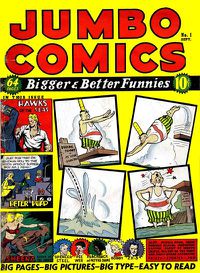Comics
Comics are a medium / artform / literary form which combines words and pictures, usually in sequential panels (though single-panel cartoons exist as well) to tell a story or otherwise communicate information or entertainment.
Although some prior examples of sequential art exist going back centuries, comics in their modern form are considered to have begun with The Yellow Kid in 1895, which began the custom of using comic strips as a newspaper feature. Usually newspapers publish a page of comics daily, and a larger comic section in color on Sunday. Comics are also published in magazine or pamphlet form as comic books, a medium which began in the 1930s and became very popular with the rise of superheroes such as Superman. Longer-form comic books in trade-paperback or hardcover form are referred to as graphic novels. Mainstream comics were for a long time regarded by many as a medium for kids, but comics are published for a wide range of target ages, including "Adults Only" comics (which have sometimes faced legal troubles). In the 1960s "Underground Comix" emerged in conjunction with the counterculture movements of that time. From the 1980s on, various "independent" publishers (from small mom-and-pop operations to sizable companies) have challenged the big corporate publishers such as DC and Marvel, though the comic market largely moved from mainstream newsstands and drugstores to specialized comic stores catering to a fan community.
Comics have a variety of literary, artistic, and narrative conventions unique to the medium, which are discussed (in comic-book form) by Scott McCloud in his book Understanding Comics (ISBN 0-87816-243-7). Another book of interest in learning about the history of the comics medium is The Rise of the Graphic Novel by Stephen Weiner (ISBN 1561-63702-5).
A variety of comics native to Japan is called manga, with its own set of conventions different from the American ones. Manga have also been popular in the United States for a number of years now. One characteristic of traditional manga is that the books open from what seems to westerners as the back of the book, since Japanese writing goes this way (like Hebrew and Arabic). Some English translations of manga flip the direction (which reverses all the art) to be more accessible, while others keep everything in the order of the original, requiring it to be read "backwards".
Like most media, comics have also developed electronic formats. Even before computers commonly had graphic support, a tradition of ASCII Art (or variants like ANSI Art) existed where pictures and cartoons were created entirely with text characters (which generally needed to be output in fixed-width characters rather than variable-width fonts, in order for the artwork to line up properly). The rise of computer graphics allowed fully graphical computerized comics, and once the Web caught on, web comics (such as xkcd, Penny Arcade, Saturday Morning Breakfast Cereal, Bad Machinery, and Dinosaur Comics) became popular. Many newspaper comic strips are now readable online, and the major comic book publishers now offer electronic editions of their comics for sale, which can be read on computers, tablets, and e-book readers.
Electronic comics may exist in a variety of formats, including graphics, Electronic Publishing formats, and document formats. Comic Book Archive is a format for distribution of scanned-in comic books.
Discussions of comics
- Quimps, Plewds, And Grawlixes: The Secret Language Of Comic Strips
- Understanding Comics (Wikipedia)
- The New Everyday: The Multimodality of Comics (essays)
- Explain xkcd
Online archives of comics
- Manga library (Internet Archive)
- Warren Publishing archives at Internet Archive
- Free downloads of out-of-copyright Golden Age comics
Other links and references
- Comics (Wikipedia)
- Webcomic (Wikipedia)
- Comic Book Legal Defense Fund fights censorship of comics
- Man Pays $10K For House, Finds $107,000 Comic Book Hidden In Wall
- API for information about Marvel Comics history
- Comic strip etched into a human hair
- Cool New App Lets You Make Futuristic Comics on the Fly
- Doctoral dissertation in graphic novel form
- Q-Collection comic book preservation project
